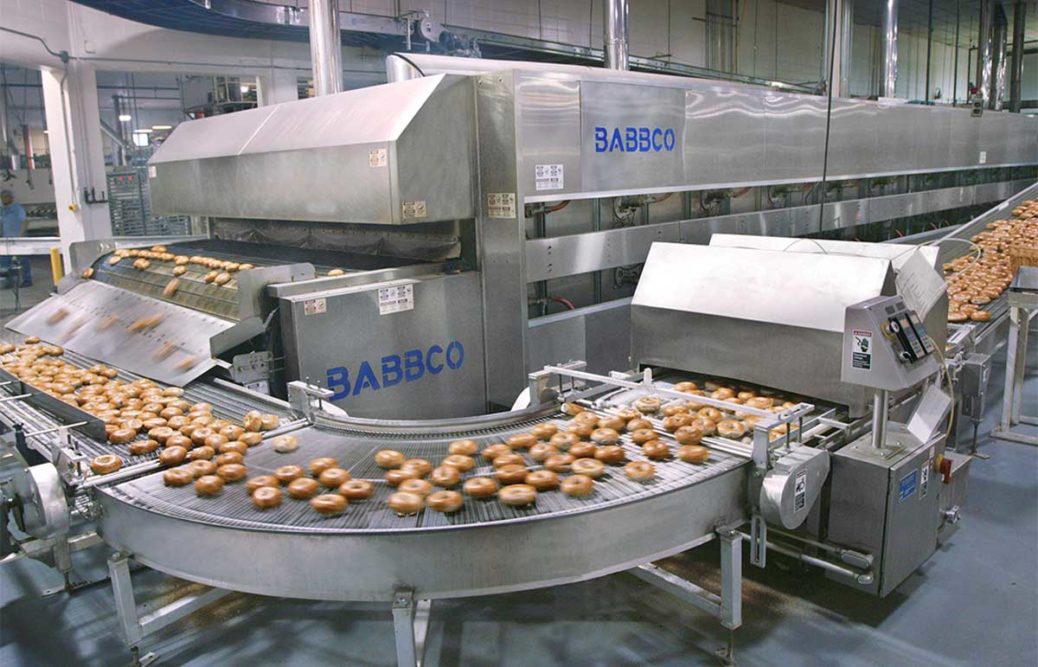The forming and boiling/steam stage of production may hold special challenges for bagels, but the end products can still get tricky — or sticky — in the oven.
“Baking the bagel requires a lot of energy from the start of cooking to ensure its development and prevent sticking,” said François Retailleau, product manager, Mecatherm. “For this reason, the oven hearth has to reach a certain temperature before the bagels are deposited onto it.”
As with every step of the process so far, baking requires precise control over the baking curve to achieve the proper texture, color and even ensure the bagel doesn’t stick to the oven. Bagels are incredibly tacky coming out of the boiler, and if this is not addressed before they enter the oven, bakers risk a mess. Gas dryers initially addressed this issue when industrial bagel production was developed.
“Later in the process evolution, dryers were replaced by various release sprays that were applied to the baking surface to ensure that the product does not stick to the hearth,” said Alex Kuperman, chief executive officer, ABI Ltd. Infrared heating systems on modern dryers use fewer burners and consume less gas to dry the bottom of the bagels after they exit the boiler and before they enter the oven.
Precise control over the baking curve is also key to setting the bagel’s structure and achieving the right color.
“The oven is really the key process element,” said Jerry Barnes, vice president, Babbco. “Consistent temperature and heat transfer as well as the ability to modulate for any production gaps are all factors in producing an even bake.”
Babbco achieves this consistency with high-output ribbon burners, high-flow convection and the latest PLC platforms. Vision systems monitor the bagels for color variation in real time and alert operators to any quick adjustments that need to be made.
Steam in the oven helps bakers achieve the coveted shiny crust on their bagels, which AMF’s Den Boer tunnel ovens deliver in addition to a uniform bake.
“The even heat distribution across the width of the oven produces a uniform product size and shape,” said Dennis Kauffman, product group leader, AMF BakeTech.
Air turbulence comes into play to achieve that even bake across the oven chamber. Gemini/W&P indirect-fired tunnel ovens’ turbulence system relies on either radiant heat or a combination of radiant and convection that can be added to all zones of the oven. Variable-speed blowers control airflow, which is reversible top-to-bottom or bottom-to-top.
“A stainless steel moisture evacuation damper in each oven turbulence section can be adjusted and fine-tuned to create an ideal moisture retention or removal profile for each product,” said Ken Johnson, president, Gemini Bakery Equipment.
The baking surface also can contribute to the final appearance of the bagel. Some bagel producers may want marks on the surface while others prefer a smooth crust.
For bagels with a smooth bottom, Shilpa Builta, account manager, Mecatherm, recommended FTP technology with metal plates, but when markings from the hearth are acceptable, she suggested Mecatherm’s M-TA oven.
“The power, precision and flexibility of this oven means that precise adjustments can be made to respond to the challenges of the bagel,” she said.
Even baking isn’t the final challenge on the production line because the unique crust is not fully set and can become deformed if the bagel isn’t removed from the oven belt with care, Ms. Builta urged.
Making bagels can be tricky, but by exercising the control today’s technology affords, bakers can achieve consistent, high-quality products. With a well-integrated production line, programmed with precision, bakers can rest assured that their bagels are exactly what consumers want.
This article is an excerpt from the February 2021 issue of Baking & Snack. To read the entire feature on bagel processing, click here.






